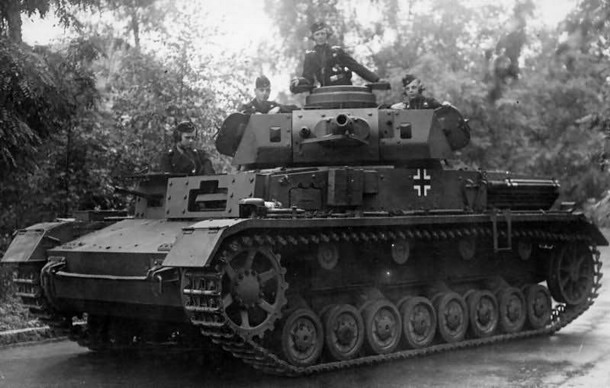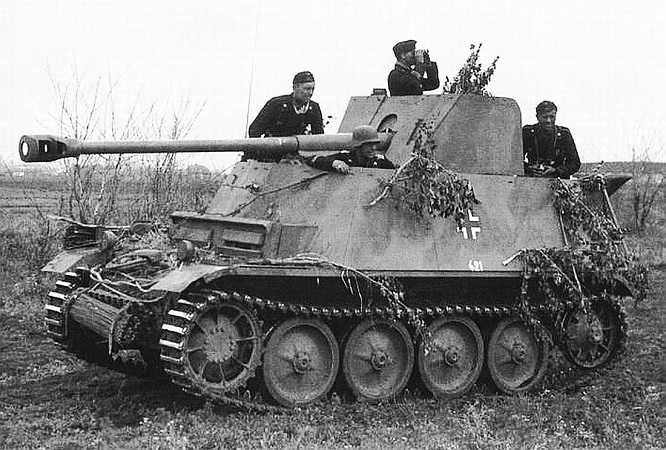After the big battles and high
casualties they suffered in the opening campaigns on the
Eastern Front, the German Army’s panzer divisions required
major refitting and rehabilitation. In late 1941, therefore
a new table of organization was issued for the standardized
1942 Panzer Division.
The new
panzer division embodied three major elements. The panzer
regiment of three battalions had 221 gun-armed tanks: 74 x
Panzer II (20mm gun), 106 x Panzer III (50mm L/42 or L/60 gun) and 30 x
Panzer IV (75mm L/24). Each
battalion had in addition a number of Bef Panzer III
(command/signal tank with no main gun). The motorized rifle brigade
had two
regiments, each with two battalions; one battalion of each
regiment was equipped with armored halftracks. The motorized field
artillery regiment has two light battalions (12 x
105mm howitzer each) and one heavy battalion (with either
12 x 150mm howitzer or 8 x 150mm howitzer and 4 x 105mm gun). The
artillery regiment had halftrack prime movers for its
howitzers and guns,
and included a flak (antiaircraft) battalion with halftrack-towed 88mm and
20mm guns.

Panzer IV tank, armed with the
short-barreled 75mm L/24 gun (World War Photos)
The panzer divisions'
armored
reconnaissance battalion (Panzer-Aufklärungs-Abteilung)
was a mixed unit with a variable number of armored car
companies, motorcycle infantry companies, light armored
companies equipped with armored halftracks, and a motorized
heavy company with support weapons. Divisions earmarked for
the 1942 summer offensive mostly had reconnaissance
battalions with one armored car company, two motorcycle
infantry companies, a light armored company equipped with
halftracks and a heavy
company. Those on other fronts mostly had motorcycle
infantry battalions, sometimes including an armored car
company. The motorized antitank (AT) battalion (Panzerjäger-Abteilung)
had six self-propelled (SP) tank destroyers and a mix of
75mm, 50mm and 37mm towed guns, depending on availability.
One company of the engineer battalion had armored
halftracks.
Such
was the desired standard but in practice it could not be met
for all panzer divisions, of which there were now 26. (This
figure includes the Army's elite formation, the
Infanterie-Division Großdeutschland (motorisiert), which despite its title was
equipped almost on a par with the panzer divisions.) Those
divisions earmarked for the 1942 summer offensive in the
southern Soviet Union were brought up to about 80-85% of
authorized strength but those on other sectors of the front
were much weaker. In Army Group South, panzer regiments with
German tanks mostly had the authorized three battalions. But
both the Panzer IV and the Panzer II were in particularly
short supply, leaving many regiments understrength. The
9.
Panzer-Division, for example had only 22 of its authorized
24 Panzer IIs. In the Panzer IV companies one
platoon (four tanks) had been provisionally deleted,
reducing the authorized total from 42 to 30; it was hoped to
restore them when sufficient Panzer IVs became available.
In most
divisions the Panzer III and Panzer IV tanks on hand were a
mix of models. The 13. Panzer-Division, for example, had 41
x Panzer IIIH with the 50mm L/42 gun and 30 x Panzer IIIJ
with the more powerful 50mm L/60 gun. The Panzer IVs of the
3. Panzer-Division consisted of 21 F1 models with the
75mm L/24 gun and 12 F2 models with the high-velocity 75mm
L/43 gun. One of the divisions earmarked for the summer
offensive, 22. Panzer-Division still
had obsolescent Panzer 38(t) tanks (ex-Czech, armed with a
37mm L/48 gun) substituting for its authorized Panzer IIIs.
Nor was
it possible to equip one battalion in each motorized rifle
regiment with armored halftracks; in many divisions
only one or two companies had them. Similar shortages
afflicted the
AT battalion. Both 75mm and the 50mm
antitank guns were in short supply, and in some divisions
captured 47mm AT guns of Czech, French or Belgian origin
were substituted. The SP tank destroyer was the Marder II
(based on the Panzer II tank chassis) or Marder III (based on the Panzer 38(t) tank chassis) armed
with either the German 75mm AT gun or the captured Soviet
76.2mm field gun modified to fire German ammunition. The
Marders were considerably more effective than towed AT guns,
but only eleven panzer divisions had them.

Marder III SP tank destroyer, based on the
Panzer 38(t) light tank (Bundesarchiv)
After the
1942 campaign, which culminated in the Stalingrad
catastrophe, the panzer divisions had to be rebuilt again.
The same basic organizational template was followed but new
weapons such as the Panzer IVG armed with the 75mm L/43 gun, the Panzer V (Panther) tank
armed with a 75mm L/70 gun, and SP field artillery were
gradually introduced. It was intended equip the antitank
battalion entirely with SP tank destroyers but as usual
equipment shortages prevented this and the AT battalions got
whatever was available, typically a mix of SP tank
destroyers and halftrack-towed 75mm guns. The
12. Panzer-Division, for instance, had one SP and one
towed company in its AT battalion. In the armored
reconnaissance battalion, motorcycles were gradually phased
out in favor or armored cars and light armored halftracks.
By dint
of extraordinary efforts the panzer divisions were rebuilt
to perhaps 85% of their authorized strength in time for the
1943 summer offensive at Kursk (July 1943). The rebuilding
was supervised by Colonel-General Heinz Guderian, the German
Army’s leading armored warfare expert, who had been dismissed
from his command in December 1941 after disagreements with
Hitler. He was brought back on active duty as
Inspector-General of Panzer Troops, and it was mainly thanks
to him that the Army’s mobile forces were restored to
fighting trim. But Guderian warned against the Kursk
offensive, which he regarded as a dangerous gamble. He
argued for a strategic defensive on the Eastern Front during
1943, with the panzer divisions held in reserve. But his
advice was disregarded and the panzers were committed to
battle at Kursk—where the turning point of the war in the
East was reached.
See Also
Panzer
Divisions 1935-40 and
Panzer Divisions 1944-45
● ● ●